Dodanie favicon do bloga WordPress jest prostym, ale potężnym krokiem do budowania marki witryny. Favicon to mały obrazek, który pojawia się obok tytułu witryny na kartach przeglądarki, w zakładkach i nie tylko.
Problem polega na tym, że wielu początkujących blogerów pomija ten szczegół lub uważa, że jest on zbyt techniczny. Z drugiej strony, brak favicon może utrudnić odbiorcom identyfikację witryny na pierwszy rzut oka, co może zmniejszyć liczbę odwiedzin lub zaangażowanie.
W WPBeginner jednym z powodów, dla których używamy favicon, jest pomoc naszym czytelnikom w szybkim rozpoznaniu naszej witryny wśród ich otwartych kart i zakładek. Ten szczegół pomaga również wzmocnić naszą markę i zapewnić bardziej profesjonalną obecność online.
Na szczęście dodanie ikony favicon do bloga WordPress nie musi być skomplikowane. W tym przewodniku omówimy proste metody konfiguracji ikony witryny i wyróżnienia bloga.
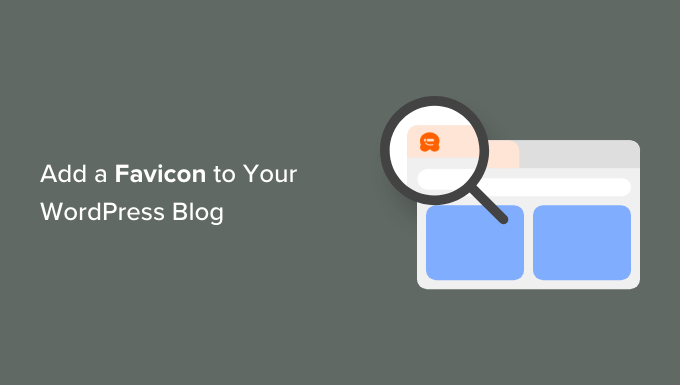
Dlaczego powinieneś dodać Favicon do twojego bloga WordPress?
Ikona favicon jest niezbędna do dodania do twojego bloga WordPress, ponieważ pomaga użytkownikom szybko zidentyfikować twoją witrynę internetową i wzmocnić tożsamość marki. Na podstawie tej małej ikonki odwiedzający witrynę mogą łatwo rozpoznać twój blog.
Oto jak wygląda favicon w przeglądarce internetowej:

Innym celem favicon WordPress jest poprawa komfortu użytkowania. Gdy otwartych jest wiele kart, użytkownicy mogą spojrzeć na favicony, aby wiedzieć, na której witrynie internetowej się znajdują i przełączyć się na tę, którą chcą.
Jeśli użytkownicy dodadzą ikonę skrótu lub zakładkę do twojego bloga na swoich urządzeniach mobilnych, wówczas ikona favicon pojawi się jako ikona aplikacji na ich ekranie głównym. Ułatwi im to dostęp do twojej witryny internetowej za pomocą jednego dotknięcia.
Favicony mogą również pomóc w optymalizacji WordPress pod kątem wyszukiwarek (SEO). Jeśli zwrócisz uwagę na strony w wynikach wyszukiwania, zazwyczaj mają one funkcję favicon witryny przed meta tytułem strony. Może to sprawić, że twoja witryna internetowa będzie wyglądać na legalną i godną zaufania.
Jak stworzyć Favicon dla twojego bloga WordPress?
Najpierw dowiedzmy się, jak stworzyć dobrą faviconę dla twojego bloga.
Idealny rozmiar favicon WordPress to kwadratowy obrazek o szerokości i wysokości do 512 pikseli. Format obrazka favicon może być ICO, JPEG, PNG lub GIF.
SVG jest również popularnym formatem dla faviconów, ale nie są one domyślnie akceptowane przez WordPress. Można jednak skonfigurować WordPress tak, by zezwalał na dodawanie plików SVG.
Jeśli prowadzisz blog biznesowy, możesz użyć logo swojej marki jako ikony favicon. Jeśli jeszcze go nie masz, możesz zapoznać się z naszym przewodnikiem dla początkujących, jak stworzyć logo dla swojej witryny.
Jeśli masz gotowe logo, ale chcesz, aby tło było przezroczyste, możesz użyć Photoshopa lub darmowego narzędzia do edycji obrazu z automatycznym usuwaniem tła. Upewnij się tylko, że format pliku to PNG, aby zachować przezroczystość favikony.
Inną opcją jest darmowy generator favicon, taki jak Favicon.io. Narzędzie to umożliwia dostosowanie favicon od podstaw i pobranie plików w formacie PNG i ICO.
Mając to na uwadze, oto jak łatwo dodać faviconę do swojego bloga WordPress. Omówimy 4 metody i możesz kliknąć poniższe linki, aby przejść do metody, której chcesz użyć:
Gotowy? Zaczynajmy.
Metoda 1: Dodanie ikony Favicon za pomocą konfiguratora WordPress
Jest to najprostsza metoda zmiany favicon w WordPress. Wszystko, co musisz zrobić, to przesłać swój obrazek favicon do konfiguratora WordPress, a reszta zostanie załatwiona za Ciebie.
Pierwszym krokiem jest uzyskanie dostępu do konfiguratora WordPress. Jeśli korzystasz z klasycznego motywu, możesz przejść do Wygląd ” Dostosuj , aby to zrobić.
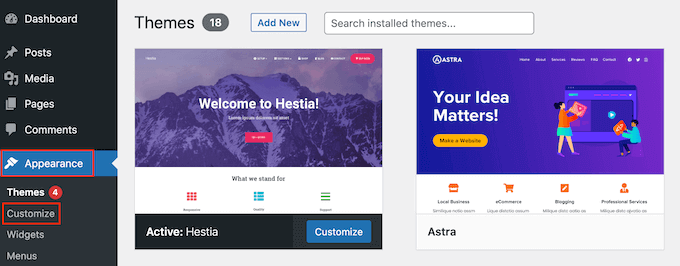
Jeśli korzystasz z motywu blokowego i nie możesz znaleźć konfiguratora, zapoznaj się z naszym przewodnikiem na temat poprawki brakującego konfiguratora motywu w panelu administracyjnym WordPress.
Następnie kliknijmy kartę “Tożsamość witryny” na lewym pasku bocznym.
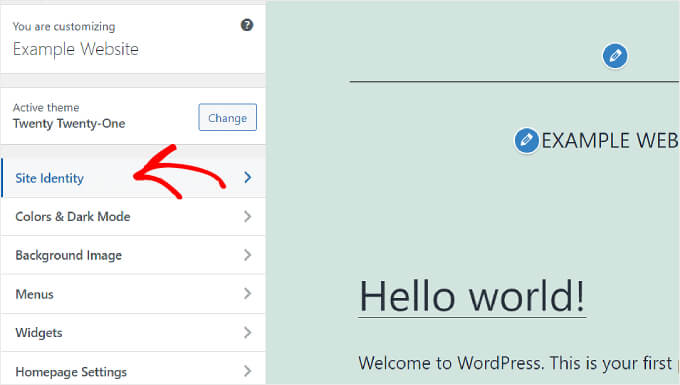
Tutaj zobaczysz opcje dostosowania “Logo witryny”, “Tytułu witryny”, “Tagline” i “Ikony witryny”.
Jeśli chcesz dodać ulubioną ikonę witryny, musisz przewinąć w dół do sekcji “Ikona witryny” i kliknąć “Wybierz ikonę witryny”.
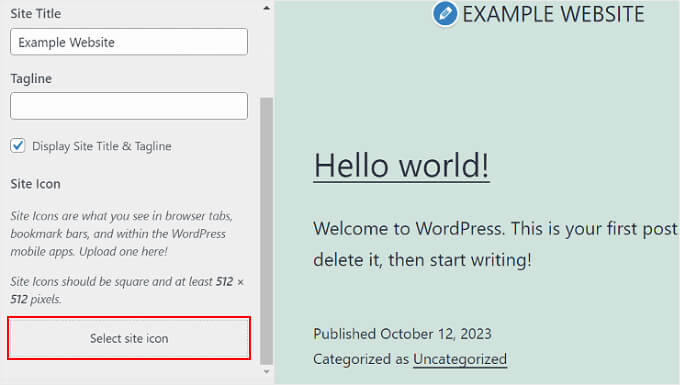
Pojawi się teraz biblioteka multimediów WordPress. Możesz wybrać istniejący obrazek lub przesłać nowy własny favicon z twojego komputera.
W tym przykładzie użyjemy logo WPBeginner jako ikonki witryny WordPress.
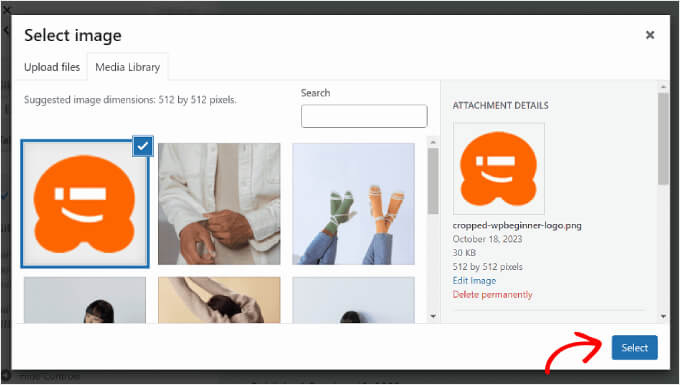
Po wybraniu obrazka kliknij przycisk “Wybierz” w prawym dolnym rogu okna.
Jeśli favicon jest większy niż zalecany rozmiar, WordPress pozwoli ci go przyciąć. Jeśli dokładnie odpowiada zalecanemu rozmiarowi, możesz go po prostu zostawić bez zmian.
Gdy obraz będzie wyglądał dobrze, kliknij “Przytnij obraz”.
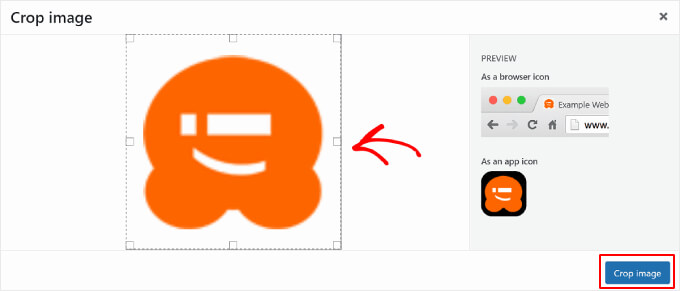
Następnie zostaniesz przeniesiony z powrotem do WordPress Customizer. Tutaj możesz zakończyć konfigurację favicon, klikając przycisk “Opublikuj” na lewym pasku bocznym.
To wszystko! Po przesłaniu ikony favicon możesz odwiedzić swoją witrynę WordPress, aby sprawdzić, czy obraz jest już aktywny.
Metoda 2: Dodanie ikony Favicon za pomocą edytora witryn WordPress
Jeśli korzystasz z motywu blokowego i chcesz dodać logo twojej marki zarówno jako część nagłówka witryny internetowej, jak i ikonkę witryny, to ta metoda jest dla ciebie.
W tym celu należy przejść do Wygląd ” Edytor z panelu administracyjnego WordPress.
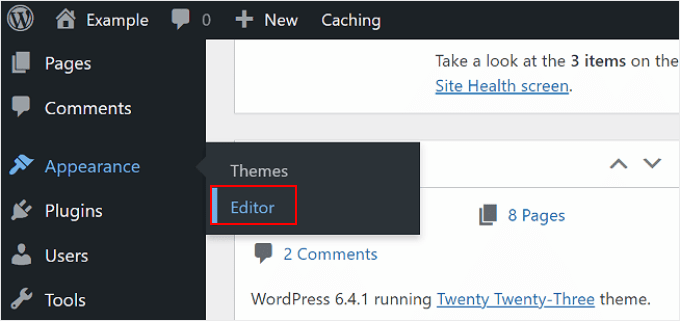
Na tej stronie znajduje się kilka menu umożliwiających dostosowanie witryny, w tym “Nawigacja” i “Style”.
W tym poradniku należy kliknąć “Wzorce”, aby uzyskać dostęp do twojego wzorca bloku nagłówka witryny internetowej.
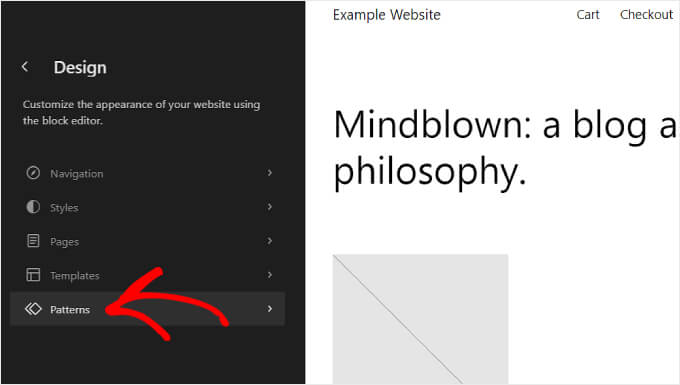
Po przewinięciu w dół zobaczysz kilka części szablonu:“Nagłówek“, “Stopka” i “Ogólne”.
Wystarczy kliknąć szablon “Nagłówek”, aby dodać tam twoją faviconę.
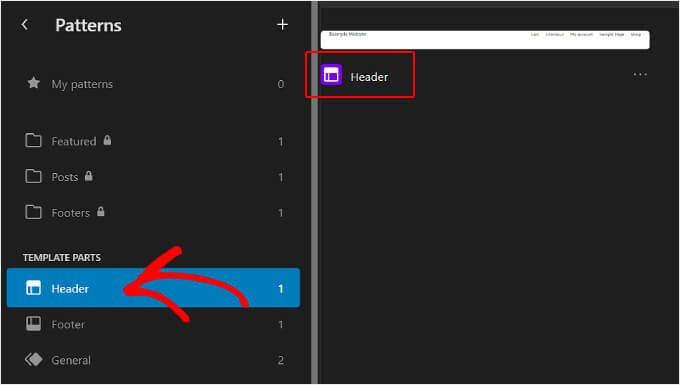
Następnie obok tekstu nagłówka pojawi się przycisk z ołówkiem.
Kliknij na nią, aby móc edytować wzór i wstawić swoją favikonę WordPress.
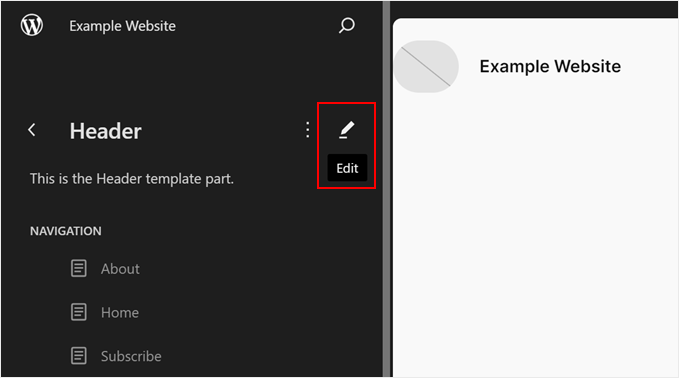
Znajdujesz się teraz w pełnej edycji witryny WordPress.
Stąd możesz kliknąć przycisk dodawania bloku “+” i wyszukać blok “Logo witryny”. Jest to miejsce, w którym dodasz obraz, który stanie się twoją favikoną WordPress.
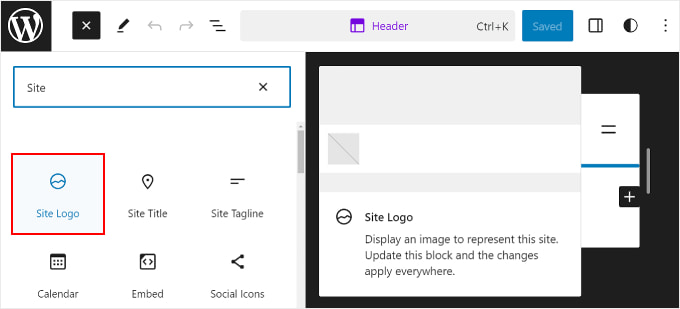
Przeciągnij i upuść blok w miejscu, w którym chcesz go umieścić w twoim nagłówku. W tym przykładzie umieściliśmy go obok tytułu witryny internetowej.
Następną rzeczą, którą należy zrobić, jest kliknięcie ikony przesyłania w bloku “Logo witryny”.
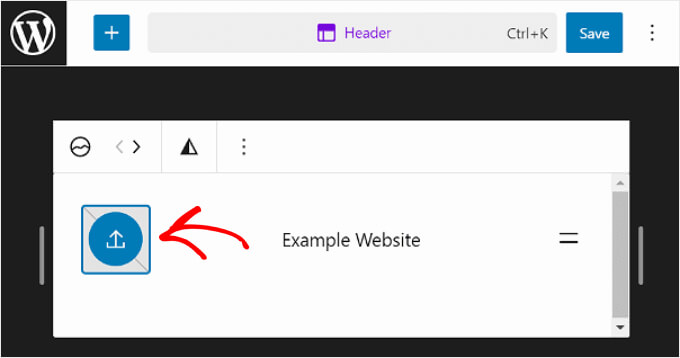
Podobnie jak w przypadku poprzedniej metody, możesz wybrać istniejący obrazek lub przesłać nowy z biblioteki multimediów WordPress.
Następnie należy przejść do panelu bocznego Block settings po prawej stronie strony. Wystarczy włączyć ustawienie “Użyj jako ikonki witryny”, aby dodać logo jako faviconę.
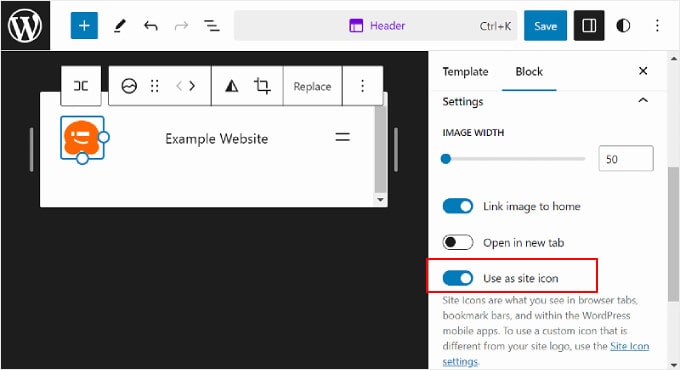
Na koniec możesz nacisnąć przycisk “Zapisz” w prawym górnym rogu strony, aby opublikować swoją faviconę.
Pojawi się ostrzeżenie, że zmiana wpłynie na całą witrynę. Upewnij się, że pole “Ikona” jest zaznaczone i ponownie kliknij “Zapisz”.
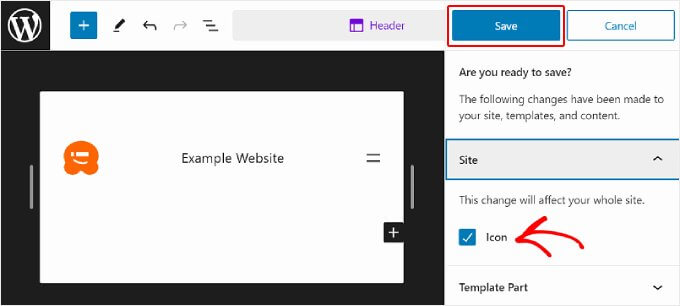
Po wykonaniu wszystkich kroków możesz otworzyć swoją witrynę internetową, aby potwierdzić, że zmiana się powiodła.
Metoda 3: Dodanie Favicon za pomocą wtyczki WordPress Favicon Plugin
Jeśli wolisz używać wtyczki favicon WordPress, możesz skorzystać z tej metody, aby użyć darmowej wtyczki Favicon by RealFaviconGenerator.
Najpierw należy zainstalować i aktywować wtyczkę. Aby uzyskać więcej informacji, możesz skorzystać z naszego przewodnika na temat instalacji wtyczki WordPress.
Po aktywacji można przejść do sekcji Wygląd ” Favicon w kokpicie WordPress.
Następnie wystarczy kliknąć przycisk “Wybierz z biblioteki multimediów”, aby przesłać nowy obraz lub użyć istniejącego.
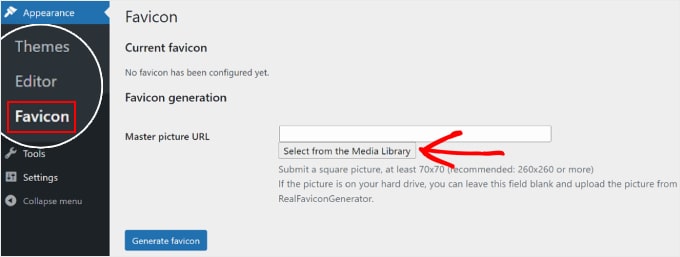
Należy pamiętać, że konieczne będzie użycie kwadratowego obrazu. Wtyczka zaleca, aby rozmiar ikonki witryny wynosił co najmniej 260 pikseli zarówno w szerokości, jak i wysokości, ale nie mniej niż 70 pikseli.
Po wybraniu obrazu, kliknij przycisk “Generuj favicon”.
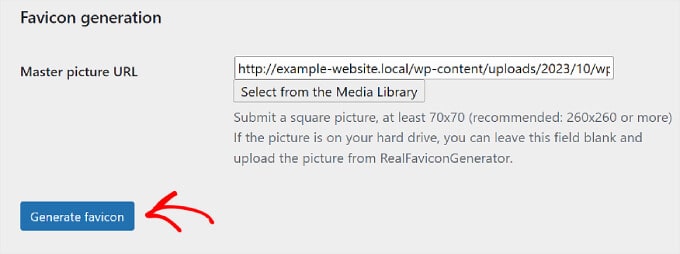
Następnie wtyczka przekieruje cię do witryny internetowej RealFaviconGenerator, aby edytować favicon.
Możesz dostosować różne ustawienia, takie jak kolor tła i wygląd na stronach wyników wyszukiwania Google (SERP), iOS, Android, macOS Safari, Chrome i Windows Metro.
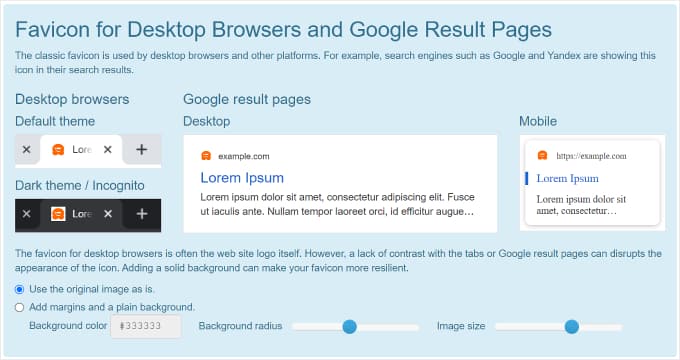
W sekcji “Opcje generatora favicon” możesz zaznaczyć pole, aby sprawdzić, czy Twoja witryna korzystała wcześniej z favicon. Jeśli tak, wystarczy wpisać liczbę w drugim polu, aby wskazać używaną wersję favicon.
W ten sposób użytkownicy, którzy wcześniej przeszli na twoją witrynę, zobaczą nową faviconę zamiast starej.
Gdy wszystko wygląda już dobrze, wystarczy kliknąć przycisk “Generate your Favicons and HTML code”, aby dodać faviconę do twojej witryny WordPress.
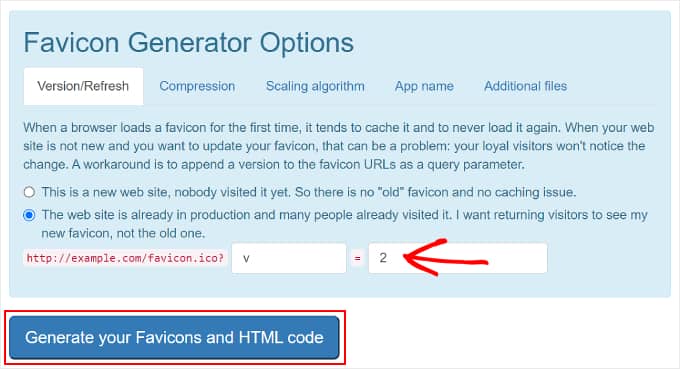
Twój favicon powinien być teraz aktywny. Upewnij się, że wtyczka favicon WordPress jest włączona, aby favicon był zawsze włączony.
Metoda 4: Ręczne dodanie ikony Favicon do twojego bloga WordPress
Wreszcie, możesz dodać favicon WordPress do twojego bloga, ręcznie edytując pliki kodu twojego motywu.
Jest to przydatne, jeśli w narzędziu Theme Customizer nie ma sekcji “Site Identity” lub używasz motywu blokowego i chcesz mieć inny obraz favicon niż logo witryny.
Najłatwiejszym i najbezpieczniejszym sposobem edycji plików kodu twojego motywu jest użycie wtyczki WPCode.
WPCode to najlepsza wtyczka do fragmentów kodu dla początkujących. Dzięki ponad 1700 gotowym fragmentom kodu i bezpiecznej obsłudze błędów pozwala bezpiecznie wstawić niestandardowy kod bez uszkadzania witryny.

Kolejną wspaniałą rzeczą w WPCode jest to, że jeśli zaktualizujesz swój motyw, nie stracisz modyfikacji kodu, w tym favicon.
Na potrzeby tego przewodnika można skorzystać z darmowej wersji WPCode. Subskrypcja Pro zapewnia jednak dostęp do funkcji takich jak inteligentna logika warunkowa i integracje z aplikacjami innych firm, dzięki czemu twój kod może być zarządzany bardziej efektywnie.
Aby rozpocząć, należy zainstalować i włączyć WPCode. Aby uzyskać więcej informacji, możesz zapoznać się z naszym przewodnikiem krok po kroku, jak zainstalować wtyczkę WordPress.
Następną rzeczą, którą musisz zrobić, jest przygotowanie twoich plików favicon. W tym celu możesz skorzystać z darmowego generatora favicon, takiego jak Favicon.io.
Na stronie internetowej można kliknąć “Obraz”, aby przekonwertować plik graficzny na plik zip i kod HTML. Alternatywnie możesz użyć opcji “Emoji” lub “Tekst”, aby utworzyć faviconę przy użyciu dostępnych emoji i czcionek.
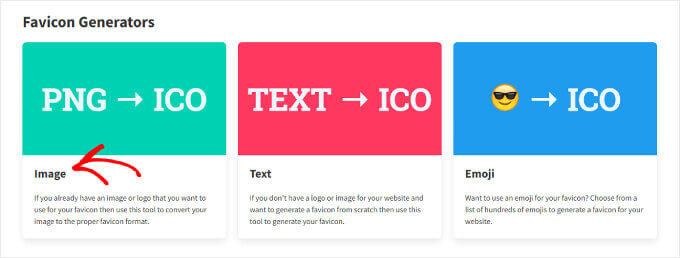
Na następnej stronie możesz przesłać swój obraz. Następnie kliknij “Pobierz”, aby zapisać plik zip favicon, który zawiera pliki favicon.png i favicon.ico.
Pamiętaj, aby pozostawić tę stronę otwartą podczas wykonywania kolejnych kroków.

Teraz należy przesłać plik zip favicon do katalogu głównego witryny. Aby to zrobić, możesz użyć menedżera plików swojego hostingu WordPress.
Alternatywnie można to zrobić za pomocą klienta FTP, takiego jak FileZilla. Aby uzyskać więcej informacji, zapoznaj się z naszym przewodnikiem dla początkujących na temat korzystania z FTP do przesyłania plików do WordPress.
Po otwarciu plików twojej witryny internetowej za pomocą menedżera plików lub FTP, przejdź do katalogu głównego.
Katalog główny WordPress to zazwyczaj folder o nazwie “public” lub “public_html”, który zawiera najważniejsze foldery WordPress, takie jak wp-content i wp-admin.

W tym momencie możesz wyodrębnić i przesłać całą zawartość pobranego wcześniej pliku favicon do katalogu głównego.
Jeśli korzystasz z Menedżera plików, możesz kliknąć przycisk “Prześlij” u góry.

Następnie pojawi się nowa karta z prośbą o przesłanie plików.
Na tej stronie możesz kliknąć przycisk “Wybierz plik” i wybrać wszystkie pliki favicon.
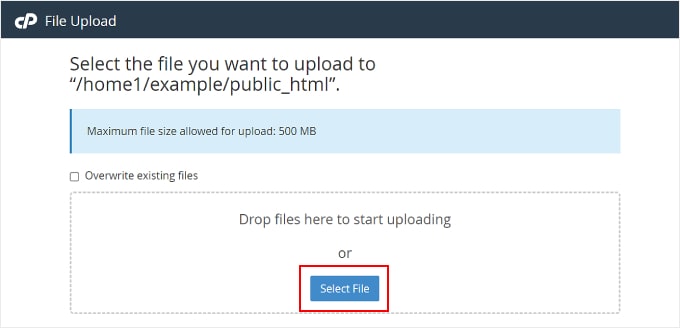
Teraz wystarczy poczekać na pomyślne przesłanie plików.
Po zakończeniu możesz wrócić do karty menedżera plików. Powinieneś teraz zobaczyć wszystkie twoje pliki favicon w katalogu głównym, jak na poniższym zrzucie ekranu:
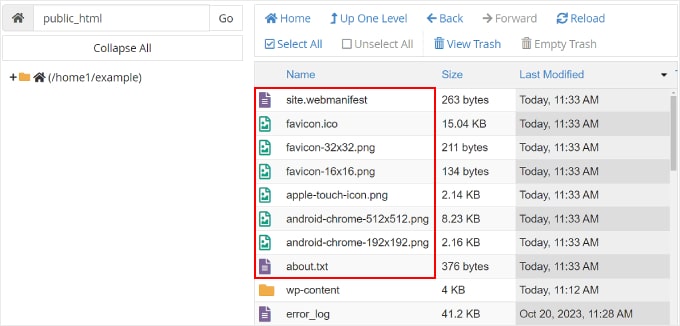
Wróćmy teraz do panelu administracyjnego WordPress.
Na lewym pasku bocznym przejdź do sekcji Fragmenty kodu ” Nagłówek i stopka.

Następnie wróć do karty Favicon.io z wcześniejszego wpisu.
Następnie należy skopiować stamtąd kod HTML. W kodzie powinny znajdować się 4 tagi odnośników .
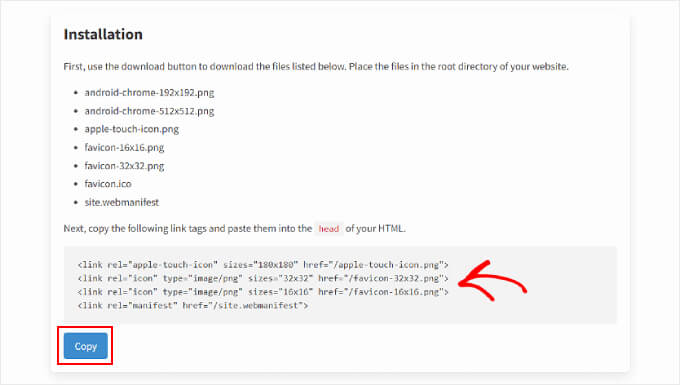
Następnie należy wrócić do WordPressa i wkleić kod w sekcji “Nagłówek” na stronie WPCode. Spowoduje to dodanie kodu do pliku header.php witryny.
W kodzie wstaw pełny adres URL twojej witryny internetowej w cudzysłowie obok wszystkich atrybutów href, jak w poniższym przykładzie. Pamiętaj, aby dodać http:// lub https://, jeśli twoja witryna korzysta z certyfikatu SSL.
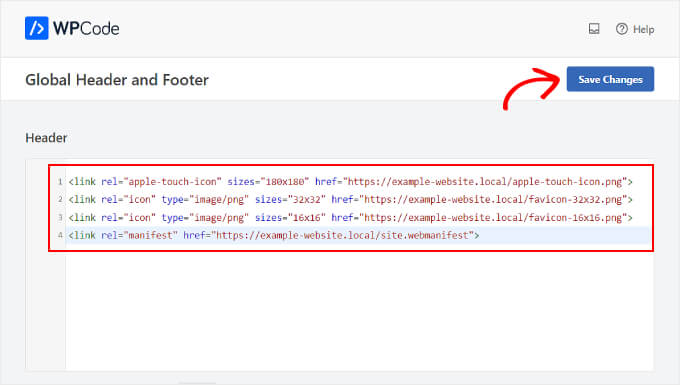
Na koniec możesz kliknąć przycisk “Zapisz zmiany” w prawym górnym rogu.
I to wszystko! Nie zapomnij przejść na swoją witrynę internetową, aby sprawdzić, czy zmiana favicon się powiodła.
Dlaczego moja ikona Ulubionych WordPress nie jest wyświetlana?
Jednym z powodów, dla których twój favicon WordPress może się nie wyświetlać, jest pamięć podręczna przeglądarki. Oznacza to, że twoja przeglądarka nadal wyświetla starą wersję twojej witryny.
Aby rozwiązać ten problem, należy wyczyścić pamięć podręczną przeglądarki. Jeśli potrzebujesz pomocy, możesz skorzystać z naszego przewodnika na temat czyszczenia pamięci podręcznej w przeglądarce.
Możliwe jest również, że korzystasz z usługi CDN, która nadal przechowuje starą wersję twojej witryny. W takim przypadku należy wyczyścić pamięć podręczną CDN, aby zaktualizować treść twojej witryny internetowej.
Aby sprawdzić, czy ikona witryny WordPress została przesłana, możesz otworzyć witrynę w trybie incognito lub w oknie przeglądania prywatnego.
Jeśli instalacja favicon nie powiodła się, możesz spróbować ponownie załadować obrazek z inną nazwą pliku, aby rozwiązać problem.
Twoja funkcja ikonki witryny WordPress może również nie działać z powodu błędu mieszanej treści. Aby rozwiązać ten problem, zapoznaj się z naszym przewodnikiem na temat poprawki błędów mieszanej treści WordPress.
W niektórych przypadkach możesz również odkryć, że Twoja witryna internetowa wyświetla favicon dostawcy hostingu zamiast Twojej własnej. Jeśli tak się stanie, skontaktowanie się z zespołem pomocy technicznej może pomóc w rozwiązaniu problemu.
Zalecamy wybranie renomowanej usługi hostingowej WordPress z doskonałą pomocą techniczną dla klientów, aby skutecznie rozwiązywać takie problemy. Możesz sprawdzić naszą listę najlepszych dostawców hostingu WordPress, aby znaleźć najlepszą opcję dla twojej witryny internetowej.
Na koniec możesz sprawdzić, czy Twój motyw WordPress ma specjalne narzędzie do przesyłania favicon. Może to wyjaśniać, dlaczego powyższe metody nie działają.
Mamy nadzieję, że ten artykuł pomógł Ci dodać ikonę favicon do Twojej witryny WordPress. Zachęcamy również do zapoznania się z naszym wyborem najlepszych darmowych kreatorów logo, które pomogą Ci wyglądać jak profesjonalista, a także z naszym przewodnikiem na temat łatwego dodawania czcionek ikon do motywu WordPress.
If you liked this article, then please subscribe to our YouTube Channel for WordPress video tutorials. You can also find us on Twitter and Facebook.





Hajjalah
This article was so helpful for me because I was wondering why other websites logos are present in search results while mine wasn’t there. When I used “Method 1: Adding a Favicon Using the WordPress Customizer” Google was the only engine showing up, I also used “Method 3: Adding a Favicon Using a WordPress Favicon Plugin” and then Yandex search started showing up but, Bing search results failed to show my Favicon. I don’t know why?
WPBeginner Support
If you did a search recently after changing your Favicon, the most likely reason would be that the search engine had yet to recrawl your site.
Admin
mohadese esmaeeli
In my opinion, having a favicon can attract the audience’s attention and add a stylish and aesthetic touch to the website in the browser. Perhaps it can capture the viewer’s gaze and be a distinctive feature.
mohadese esmaeeli
Hello. The favicon section of my website is not working. Even when I provide the url in the theme settings, it doesn’t show. I also tried from the site ID part, but it gives an error of not processing the image. Can you please guide me on this?
WPBeginner Support
If you are using the built-in option for your theme then we would first recommend reaching out to your theme’s support as they may have a specific requirement for the favicon image using their tool.
Admin
Jiří Vaněk
The last time I uploaded a favicon to a website, I struggled for a really long time with the icon not showing up on the website. I cleared the browser cache and wordpress itself and it didn’t help. She didn’t show up on her own until a few hours later. If someone is having trouble with it, the cache can be in many places. CDN, on the network element at home, on the server. So sometimes it’s good to just wait a while and not stress right away. Otherwise, the Favicon is a small thing, but it is a great way to customize your own page.
WPBeginner Support
Having a favicon can help with your SEO as well as to help users remember your site but it is not required and the first favicon you set can be changed to a different one later on.
Admin
Peter Iriogbe
Now I see why site owners stick to using Favicon which looks the same as their site logo.
Peter Iriogbe
Is it a must to upload a favicon or does it influence ranking on search?
Jiří Vaněk
Favicon is not necessary and does not affect SEO and search in any way. It is the personalization of the page. A favicon is great in two ways. If someone adds your page to their favorites, they will immediately recognize it by the favicon and do not have to search for a long time. The second great thing is when you have multiple pages open in your browser. You can also recognize the given page immediately by the favicon. So I definitely recommend having it, even if it doesn’t really affect SEO and search itself.
mohadese esmaeeli
Exactly, I agree. I’ve experienced the same issue. Often, when searching, I open various websites, and after an hour, I realize I have many tabs open in the Chrome browser, right in front of my eyes! However, having a favicon helps me quickly locate my desired site among the numerous tabs.
Javi
second alternative worked, thanks
WPBeginner Support
Glad to hear it worked
Admin
Meer Hamza
Is it manadatory to upload favicon at wordpress website in ICO file format.
WPBeginner Support
No, it does not need to be an ico format.
Admin
Meer Hamza
1-Is it ok to just upload site Icon from theme>customize>site Icon. Will it show as favicon?
2-I upload site Icon on wordpress website. Is it necessary to show Favicon at URL website.com/favicon
WPBeginner Support
1. Yes it is fine to upload it from there
2. It is not necessary but it can be helpful for finding the favicon later.
Admin
Alex Perry
Thanks, after 2 hours of searching I finally found it. How to change the site icon…
WPBeginner Support
Glad our guide allowed you to add it instead of needing to search further
Admin
Ben
I think this needs an update. I tried this and there’s no “Site Identity” tab under Appearance > Customize
WPBeginner Support
Your specific theme may have a custom editor or if you are using the block editor you could add the site logo block, set an image, and in the block’s settings have that set as the site’s favicon.
Admin
FAIZ
what a great guide, really it’s very helpful
WPBeginner Support
Happy to hear our guide was helpful
Admin
Max Anderson
What does the WPBeginner favicon represent?
WPBeginner Support
Our blob is a simple design of a face smiling using an exclamation point and parenthesis
Admin
AL
Hi, what to do when Favicon is not showing on chromium-based browser and shows up in Firefox.
WPBeginner Support
You would normally want to clear your site’s cache as well as try setting the favicon again for a common reason.
Admin
John
I’m new to this so would appreciate some guidance with favicon. The website I’m trying to look after needs the favicon changing. Can I load a new image as a favicon that will overwrite the favicon currently on the pages or must i delete the current one then load a new image?
Thanks for any reply
WPBeginner Support
You would want to reach out to the support for your specific theme for if your theme has this option.
Admin
Ray
I was fine on the video until you said “click on site identity”… there is no such tab on my version. The first option is “Global” then Header, Breadcrumb, UberMenu{main], Blog, etc. No “Site Identity”…so obviously without being to get to that screen I’m not going anywhere. Is there another way in?
WPBeginner Support
If your theme has different settings and you are unable to find the favicon in the customization settings, you would want to reach out to the support for your specific theme to see if they have it located in a theme-specific area.
Admin
Krishna
Hii Wpbeginner!
I’m using Astra theme my website Favicon is working every one except Google search results. How can I fixed it?
WPBeginner Support
You would need to wait for Google at the moment.
Admin
Soul sultan
This is the awesome guide about how to add favicon on wodpress blog
WPBeginner Support
Thank you, glad you found our content helpful
Admin
Shomirul Islam Bonny
Thanks! It helped me!
WPBeginner Support
You’re welcome, glad it helped
Admin
Munendra Singh
all helpful post,, thanks
WPBeginner Support
Glad you found our post helpful
Admin
Raj
Great ! I always go through from your tutorials when ever i get stuck in any kind of issue. Thanks for it.
WPBeginner Support
Thanks, glad our articles could help
Admin
John Barson
Can’t Add a Favicon to Your WordPress Website? That was my problem. I did a fair bit of research where I finally found my issue. It was because the PHP GD Library was not enabled. Fortunately, I control my own server. I had upgraded the server PHP to v7.2 but I forgot to enable the PHP GD library. So…if you find when you try to add the site icon in the appearances section of your wordpress admin and the image you upload/select is not being accepted or you can’t use the crop image feature it is most likely because your webserver host has not enabled the GD Library.
WPBeginner Support
Thanks for sharing this information should someone else run into that issue
Admin
Cean Herzfield
Thank you so much! You saved me a lot of frustration because I’m working on Xampp and it was disabled by default. Now wouldn’t it have been nice if they had mentioned it in the article.
Pritam
Favicon of my website was visible before I changed DNS for Cloudflare. Now it is visible in the admin side but not on the website. How to solve this problem. you can check on my website
Michele A
This tutorial was wonderful! Thank you so much for the great work!
Jacques
My Favicon is updating in ADMIN side, but not on user side
Tracy
Were you able to figure out how to fix it?
RAJ
“When I go to the “Site Identity” tab, there is no place to upload a site icon. The only option I have is the “Site Title”. That’s ALL!
I am using WordPress 4.7.3.”
Bekzat Sadykov
I guess, the WP theme you are using doesn’t have favicon implemented. So, if it is not declared in theme functions.php file, it won’t appear in admin/editor side.
You can hardcode it to header.php or use third-part plugins.
jacob
scroll down a little you will see the place to upload your favicon
Eleanor
Hi, I recently updated my website from HTTP to HTTPS and when that happened, the site icon stopped working. Does this mean that somewhere along the line I’ve missed a step? I’ve tried changing the image and reuploading a new one and that hasn’t worked. If someone types in the website URL using http then the old favicon (and not site icon) shows up, but the minute it’s https, then it disappears. The site icon though is visible when I’m logged into the dashboard.
Matt Parker
Eleanor
I’m on HTTPS and I have the same issue, did you find a solution?
Favicon only shows when I’m logged in in admin mode!
Jimmy
When I go to the “Site Identity” tab, there is no place to upload a site icon. The only option I have is the “Site Title”. That’s ALL!
I am using WordPress 4.7.3.
Please help!
Ahmed Akeem
I guess, the WP theme you are using doesn’t have favicon implemented. So, if it is not declared in theme functions.php file, it won’t appear in admin/editor side.
You can hardcode it to header.php or use third-part plugins.
Abubakar Sahabi Rafi
It really helped, more grease to our elbow.
Tim
Can anyone tell me how this new “Site Icon” feature is supposed to work? I get to the point where the file is uploaded and I get a dialog box that offers to crop the image. The problem is 1) my image doesn’t need to be cropped and 2) there’s no “Save” button (or “Done” or anything similar), only a “Crop” button and the upper right corner X to close the dialog. If I click “Crop” I get an error (Error cropping this image, bla bla bla) and if I hit the X it closes. Either way, my image is not saved as a Site Icon (even though it is saved in the media library. After deleting the image, resizing it to exactly 512×512, I upload it again. This time, no crop dialog, just the “Select” image dialog. I click select, the image has a box around it and a check mark and nothing else happens. No Save, etc. When I close the dialog, there’s still “No image selected.” This happens in Chrome AND Firefox. I’m ready to throw WordPress away and hand code everything. I haven’t used WordPress in a couple of years and I’m frustrated with what seems like buggy, poor design and feature bloat.
Brian
code easy to interpret, it worked out. thanks…
Jason
Why does it need to be 512 pixels for an icon? I’m hoping it’s converted somewhere inside WordPress, once and done, and not on every load. 512×512 is crazy for something that would very rarely be bigger than 32X32, unless I am missing something?
John Krawczyk
Article not useful. Everyone tells you to make a path to your favicon & that’s it.
However do you include http: www http do you specify .ico .png?
Nobody says anything in detail.
WPBeginner Support
Hi John,
Yes you need to include full URL like this:
https://www.wpbeginner.com/favicon.pngAdmin
Joe
Using WP4.7 and the Site Icon functionality works, but it just seems off to me. The result is 4 links in the section:
But it creates 10 different versions of the site icon image in addition to the original at sizes of 32×32, 100×100, 150×150, 180×180, 192×192, 250×250, 270×270, 300×300, 360×360, 500×310.
Why so many cropped images if only 4 linked to?
Also, I submit an icon image sized 512×512 as recommended, but the 500×310 version is always cropped so the top and bottom of the icon is cut off. Is there any way around this and/or is it a big deal?
What browser support does this WP Site Icon cover (mostly in respect to how far back in IE)?
Thanks!
Marieke
In Whatsapp, the image which appears left to a link address if you send a link: is that the same icon? Because I don’t see it there.
Sunil
Marieke, It’s featured image, you upload to a particular post.
Cos
The ICO Format plugin for Adobe Photoshop does not allow images more than 256 pixels high or wide. So how do you create one that’s 512px???
Marieke
It doesn’t need to be made an .ico. Just a plain .png or .lpg will do when you work in WordPress.
Salim Ahmed
Informative instruction. Now i following your tips and tricks. Thanks for sharing it.
Taimoor Ahmed
Kindly tell me any website or a software from where I can make an effective favicon for my site in a quick time????
Kirstie
Thank you for another simple to follow tutorial. I’m a true beginner and y’all do a great job explaining things in a way I can understand.
WPBeginner Support
Thanks, glad you find our tutorials helpful.
Admin
Nelson
thanks good tut easy and works
c
the add logo in some themes isn’t for favicon its for the header logo
ccstacyline
how come my side identity menu doesn’t have the service for site icon? I am so frustrated… can you help ?
John Davis Frain
Are the instructions you give here theme-specific? I’m using the Delicacy theme, and it doesn’t give me that option to alter Site Identity and insert a Favicon.
WPBeginner Support
No it is not theme specific. Make sure you are using the latest version of your theme.
Admin
Mad Dog Malcs
Hi There, I also don’t see the site identity tab, I am using the sketch theme, how do I update a theme?
Thanks in advance, Malcs
shashi
i may go to theme custimztion..there u see the option of uploading the favicon icon easliy…
Antonios
You might not see the word “favicon” probably site icon. If you see a scrow bar you might have to scrow all the way down to see the select image box.
a
You can add favicon by WordPress’ “Costumize” editor, which can be found in every wordpress site.
Alan
I upload a PNG file that is exactly 512×512 pixels, WordPress saves it, and then I end up with a cropped image in my media library. Super annoying! WordPress 4.4.
Alan
I should add that the new, cropped image is exactly the same dimensions as the original I uploaded, but now I have two in my library (albeit one has been processed twice, and has actually increased two kilobytes in file size!).
Katherine Johnston
I have gone through the directory, exactly as you described, but my Site Identity tab only has “Site Title”, “Tagline”, and a checkbox for displaying header text. How can I fix that? Or do I have to go the FTP route?
Thanks for the help!
Rahul Thakur
thank you so much, very simple way love it.
Liz
Excellent instructions, took me about 32 seconds to do it. Fabulous! Thank you
Erin
Thanks! This was very helpful.
Marie Bock
Wow! That was so easy with the newer version of WordPress.
Matt
Super-easy! Thanks for that – I just need to go away and design a better logo now